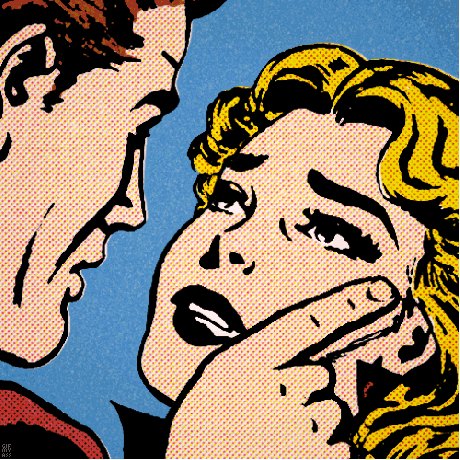To See with the Tips of One’s Fingers
Great minds think alike, great eyes see alike, great hands feel alike. All these statements apply to the unlikely duo of Nicholas Ray and Jean-Luc Godard. Although their creative output differs wildly, there are common sensibilities in their movies. Most notably between Ray’s 1973 movie We Can’t Go Home Again and Godard’s recent Adieu au langage.

More precisely, these films evoke a haptic way of viewing. The cinematic images are presented in a way that seems to be determined by (the motions of) fingers as much as by eyes.
Ray’s experimental feature frequently presents four or even five different images on screen together, slightly moving across each other in compositions that call to mind an atlas or an art book, which you leaf through. Godard’s 3D experiments and his penchant for flatness take their cue from the way we finger our phones, tapping our way from icon to app.
That is the point French film scholar Emmanuelle André makes in her essay Voir du bout des doigts (1). This video essay, a collaboration of Emmanuelle André and David Verdeure which was produced within the context of the Indefinite Visions project, is a companion piece to that text. Where the written essay presents mainly academic and art historical voices about these two directors and their respective movies, the video essay chooses to let the movie auteurs speak for themselves.
This audiovisual piece uses footage from the two aforementioned films and from related movies as well as excerpts from interviews with both directors. These snippets, some of them decades old, reveal that they did indeed think thoroughly about the relation between eyes and hands, between pointing and showing, between surface and depth. All audio in this videographic essay is from Ray and Godard, or is taken from their films. That way, they seem to be commenting on their own (and each other’s) modus operandi. A duet for four hands, Godard would call it. The video essay is organized more along the lines of a poem than as an academic argumentation: it plays on visual parallels between the films and its basic structure employs the format of the rondeau (2).
It is also a duet for three eyes. Because the video essay tries to illustrate how these directors watched the world in the same way, how their eyes were caught by similar visual configurations. Godard walking through a museum, surrounded by the flat panels of paintings on equally flat walls echoes Ray’s experiments with multiple flat images on the projection screen. Their shared love for painting is no coincidence either: isn’t painting the ultimate example of a visualization that relies on dexterity of hands and fingers?
This translation of Emmanuelle André’s text to a video essay is a only the first such effort. There is another one: a second version that uses the same material but a completely different form of presentation. You can watch and read about that second video essay here.
(1) That text was published in the cinema journal Vertigo.
(2) The rondeau is a medieval French poetry form that is characterized by the fact it uses the same refrain three times: it starts and ends with the refrain, and an abbreviated version of the refrain also pops up halfway through the rondeau. This video essay references that format by using three iterations of Jean-Luc Godard’s quote “Voilà. Voilà. Vois là.” as its refrain.
This video essay includes clips from:
We Can’t Go Home Again [feature film] Dir. Nicholas Ray. Harper College, USA, 1973. 93 mins.
Don’t Expect Too Much [documentary film] Dir. Susan Ray. USA, 2011. 70 mins.
Der amerikanische Freund [deleted scene from feature film] Dir. Wim Wenders. Bavaria Film et al., West Germany et al, 1977. 125 mins.
Adieu au langage [feature film] Dir. Jean-Luc Godard. Wild Bunch et al., France, 2014. 70 mins.
Les 3 désastres [short film] Dir. Jean-Luc Godard. Fundação Cidade de Guimarães, France et al., 2013. 17 mins.
Une catastrophe [short film – trailer for Viennale] Dir. Jean-Luc Godard. Viennale, Austria, 2008. 1 min.
Point de rencontre avec Jean-Luc Godard [television documentary] Dir. Manu Bonmariage. RTBF, Belgium, 1982. 22 mins.
Cinéastes de notre temps: Jean-Luc Godard au musée d’Art moderme de Paris [television documentary] Office national de radiodiffusion télévision française, France, 1965. 3 mins.
The music, which was also used in Adieu au langage, is:





